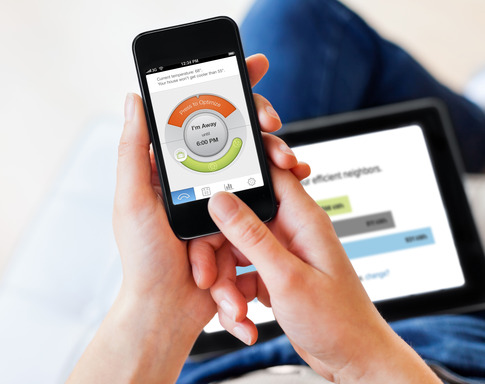Wi-Fi Thermostats Connect Utilities to Consumers
Smart meters are often seen as a technology to link the electricity grid and homes, but smart thermostats appear to be gaining more attention from technology providers and utilities.

At the utility industry conference DistribuTech this week, thermostat giant Honeywell announced its Energy Management Platform, a system developed with energy efficiency software company OPower.
It includes a programmable thermostat to schedule heating and cooling but, because it’s connected to the Internet from a home broadband connection, utilities can offer services through it. Using Opower’s cloud-based software, people fill out a questionnaire and then get customized recommendations to improve home energy efficiency. Utilities can also operate demand response programs through the thermostat, where consumers get a rebate for allowing the utility to change thermostat settings to lower energy use during peak times.
The hope is that easy-to-use smart phone and tablet apps, which let people remotely control their heating and cooling, will increase the participation in these efficiency and demand response programs. Programmable thermostats have been around for years, but are often left un-programmed because they’re hard to operate. The arrival of popular Nest thermostat and apps to program thermostats has helped make them more consumer-friendly.
Smart thermostats won’t replace smart meters, which utilities have invested in for automatic billing or to help locate power outages. But smart thermostats can help utilities better communicate with consumers and run demand response programs. Also this week, Comverge introduced utility software geared at making it easier to run demand-response with connected thermostats and home broaband.
California utility Pacific Gas & Electric, which has already installed millions of smart meters, is testing the Honeywell-Opower system and expects it can cut home energy use, both gas and electric, by five percent. Because energy data is collected and analyzed, utilities can verify savings, both monthly energy reductions, and shaving power during peak times.
Another utility, NV Energy based in Las Vegas, plans to offer demand-response services and efficiency recommendations through thermostats to 10,000 homes using software from EcoFactor. Other companies making energy software connected to thermostats include EnergyHub, Bidgely, and Nest Labs, which has a partnership with utility Reliant.
Keep Reading
Most Popular
Large language models can do jaw-dropping things. But nobody knows exactly why.
And that's a problem. Figuring it out is one of the biggest scientific puzzles of our time and a crucial step towards controlling more powerful future models.
The problem with plug-in hybrids? Their drivers.
Plug-in hybrids are often sold as a transition to EVs, but new data from Europe shows we’re still underestimating the emissions they produce.
How scientists traced a mysterious covid case back to six toilets
When wastewater surveillance turns into a hunt for a single infected individual, the ethics get tricky.
Google DeepMind’s new generative model makes Super Mario–like games from scratch
Genie learns how to control games by watching hours and hours of video. It could help train next-gen robots too.
Stay connected
Get the latest updates from
MIT Technology Review
Discover special offers, top stories, upcoming events, and more.